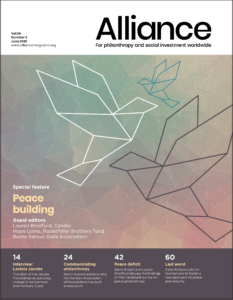An Indigenous idea helps redefine how we care for each other and Mother Earth.
‘Everyone can conjure up what ‘buen vivir’ means to them. An equilibrium between humanity and environment is something everyone can work towards.’
~María Estela Barco Huerta, Desarrollo Económico Social de los Mexicanos Indígenas
The concept of buen vivir implies ‘right living’ or life in balance with community, natural systems, and future generations. Coming from Latin American Indigenous movements, buen vivir is a powerful way to leave behind old ‘development’ or ‘security’ paradigms. Buen vivir (also known as Sumak Kawsay in Quechua or Lekil Kuxlejal in Mayan Tzeltal, for example) is based on culturally-ingrained concepts of deep respect that each person has for the spirit of every other living being, including humans, animals, nature, and the spiritual realm.
Thousand Currents partners and many other grassroots groups and movements around the world are using ancestral teachings about how we care for each other, the places where we live, and the resources we share. Here’s three examples of how buen vivir is being evoked or is guiding community self-determination based on agreements that we all want to live well, respecting the rights of Mother Earth:
Caring for our food
In Cusco, Peru, modern science and traditional knowledge are being combined to promote biodiversity and climate resilience, based on ancestral Andean principles and buen vivir. Associación ANDES (Association for Nature and Sustainable Development) has developed the Potato Park (Parque de la Papa) as a biocultural, Indigenous territory.
The Potato Park does more than ensuring that indigenous varieties of potatoes and other tubers continue to exist. The Park is also an example of communities working collectively to achieve sumaq causay, or buen vivir to protect sustainable rural ways of living and build climate resilience. It demonstrates what locally-controlled decision-making processes can achieve by connecting elders, scientists, academics, and politicians.
Generating energy
The concept of buen vivir also creates opportunities for communities to consider their interdependence and how they want to manage the land, water, and resources on which their livelihoods and their very lives depend.
In the remote village of Dhapsung, which was devastated by the 2015 Nepal earthquake, Digo Bikas Institute is supporting a community-owned and community-controlled solar grid. But it’s more than much-needed access to electricity. Without having to obtain firewood, the people of Dhapsung now have more time on their hands for school and work. There are also more places in the village that are considered safe at night. This community’s climate solution makes clean energy and offers viable alternatives that show us all how to move beyond the fossil fuel era.
Reimagining wealth
Thousand Currents co-created the Buen Vivir Fund with our partners to re-imagine our economy and our investment practices. Over the course of a year, we brought together 18 organizations who poured in hard work, careful analysis, learning exchange, and a collective total of 2,934 hours to demonstrate how financial capital can be used, shared, and, yes, increased as just one resource within a rich, interconnected ecosystem.
As the Fund invests in such groups as Whole World Women Association to provide affordable housing for women and child refugees in South Africa and in Ñepi Behña to expand marketing for a participatory certification process for ‘fair trade’ among women artisans in Mexico, already some buen vivir investment practices have emerged, such as:
- The financial investors shoulder the risk in the Buen Vivir Fund rather than pass it to the borrower, because as people of wealth, they can handle it.
- Rather than interest paid to investors, borrowers make a contribution of solidarity back into the fund, based on level of their success.
- The fund is designed to have a two-way flow of information, so investors are ‘upskilled’ and can learn new ways of being from borrowers.
Giving & grantmaking
The falsehood that we are singular, that we as individuals or as organizations can ideate or donate or consume our way to a better world without fundamentally transforming what drives inequality and environmental destruction — is one we have to actively fight against right now. Especially given the challenges to peace that the climate crisis presents, it’s time for philanthropy to get serious about moving more money in more disbursed ways than ever before.
Ancient wisdom like buen vivir and stories of learnings and awakenings passed through generations can offer the grounded solutions, ideas, and knowledge that expands our imagination for doing so.
Katherine Zavala is Director of Grassroots Partnerships at Thousand Currents
 Peace-related philanthropy, at less than 1 per cent of all grantmaking, seems irresponsibly small given that armed conflict spoils lives, divides societies and ruins economies.
Peace-related philanthropy, at less than 1 per cent of all grantmaking, seems irresponsibly small given that armed conflict spoils lives, divides societies and ruins economies.
Our new issue goes in search of philanthropy’s role in peaceful development.



Comments (1)
So relevant for other First Nations Communities!